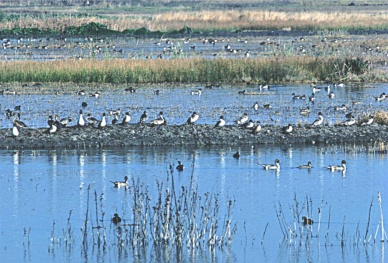How to Become a Partner
 If
you are a private landowner and are interested in restoring fish and
wildlife habitat on your property, the Partners for Fish and Wildlife
Program may be for you. If
you are a private landowner and are interested in restoring fish and
wildlife habitat on your property, the Partners for Fish and Wildlife
Program may be for you.
Project
Criteria
Your project must meet
certain criteria in order to qualify for assistance from the Partners
for Fish and Wildlife Program:
- Your project
must restore or enhance habitat.
- Your project must benefit
U.S. Fish and Wildlife Service trust species, such as migratory birds,
anadromous fish, or threatened and endangered species.
- Your project must be located
on nonfederal and non-state land.
- Your project should reestablish
natural historical communities with little maintenance.
- There should be a reasonable
expectation of success in achieving project objectives.
- You and/or other partners
must provide a viable match for the project. You can contribute cash
or may provide an in-kind contribution such as labor, use of equipment,
or materials.
- Partners for Fish and
Wildlife projects are not eligible to be used as compensatory mitigation
for purposes of meeting state and federal regulatory program requirements
The
Process
 An
interested landowner contacts a Partners
for Fish and Wildlife biologist to discuss his/her ideas and set
up a site visit. An
interested landowner contacts a Partners
for Fish and Wildlife biologist to discuss his/her ideas and set
up a site visit.
 The
landowner, the Partners for Fish and Wildlife biologist, and representatives
from other interested cooperating organizations,
meet on the property to evaluate the site and discuss the landowner's
goals and objectives. The
landowner, the Partners for Fish and Wildlife biologist, and representatives
from other interested cooperating organizations,
meet on the property to evaluate the site and discuss the landowner's
goals and objectives.
 The
Service biologist helps to determine habitat improvements that can
be made on the property that would benefit wildlife. Technical advice
on project design, material, and engineering is provided by the Service,
as appropriate. The
Service biologist helps to determine habitat improvements that can
be made on the property that would benefit wildlife. Technical advice
on project design, material, and engineering is provided by the Service,
as appropriate.
 Cost
sharing options are discussed. The goal is to achieve at least 50
percent of project costs through cost share and/or in-kind contributions
from our partners. Projects that involve greater non-Service partnerships
and/or cost sharing are more desirable. Cost
sharing options are discussed. The goal is to achieve at least 50
percent of project costs through cost share and/or in-kind contributions
from our partners. Projects that involve greater non-Service partnerships
and/or cost sharing are more desirable.
 A
habitat restoration proposal is developed by the Service biologist
with assistance from the landowner. The proposal must then compete
for the available funds. A
habitat restoration proposal is developed by the Service biologist
with assistance from the landowner. The proposal must then compete
for the available funds.
 After
funding is approved, a Wildlife Extension
Agreement is signed by the landowner and the US Fish and Wildlife
Service. The agreement must be for a minimum of 10 years. After
funding is approved, a Wildlife Extension
Agreement is signed by the landowner and the US Fish and Wildlife
Service. The agreement must be for a minimum of 10 years.
 Upon
project completion, the US Fish and Wildlife Service reimburses the
landowner. Upon
project completion, the US Fish and Wildlife Service reimburses the
landowner.
 |
| The end
result of the process: A restored wetland teeming with wildlife! |
For more information view
the Frequently Asked Questions.
Note:
Can you identify the waterbird silhouettes in the list above? Just
hold your pointer over the silhouettes to reveal the correct identification.
|

 If
you are a private landowner and are interested in restoring fish and
wildlife habitat on your property, the Partners for Fish and Wildlife
Program may be for you.
If
you are a private landowner and are interested in restoring fish and
wildlife habitat on your property, the Partners for Fish and Wildlife
Program may be for you.  The
Service biologist helps to determine habitat improvements that can
be made on the property that would benefit wildlife. Technical advice
on project design, material, and engineering is provided by the Service,
as appropriate.
The
Service biologist helps to determine habitat improvements that can
be made on the property that would benefit wildlife. Technical advice
on project design, material, and engineering is provided by the Service,
as appropriate. Cost
sharing options are discussed. The goal is to achieve at least 50
percent of project costs through cost share and/or in-kind contributions
from our partners. Projects that involve greater non-Service partnerships
and/or cost sharing are more desirable.
Cost
sharing options are discussed. The goal is to achieve at least 50
percent of project costs through cost share and/or in-kind contributions
from our partners. Projects that involve greater non-Service partnerships
and/or cost sharing are more desirable. A
habitat restoration proposal is developed by the Service biologist
with assistance from the landowner. The proposal must then compete
for the available funds.
A
habitat restoration proposal is developed by the Service biologist
with assistance from the landowner. The proposal must then compete
for the available funds. 